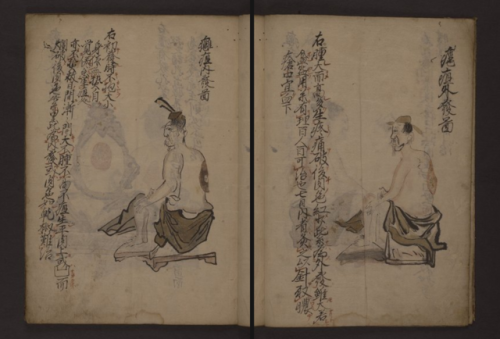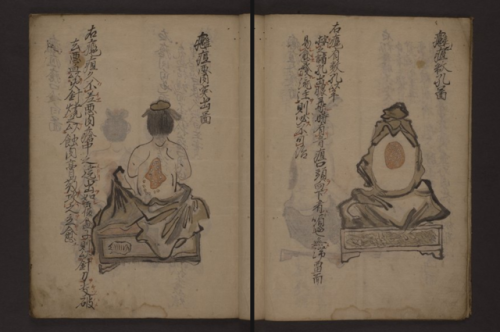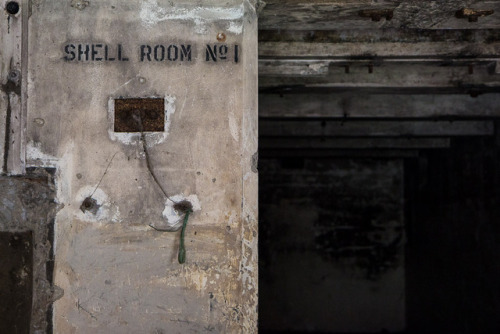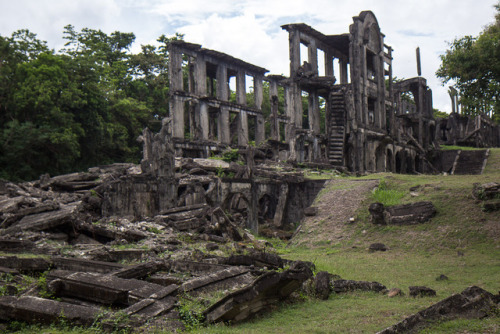One Of My Favorite Things About Working With Archival Materials Is The Opportunity To See Earlier Iterations





One of my favorite things about working with archival materials is the opportunity to see earlier iterations of familiar, everyday items, such as this 1870 U.S. passport for chemical engineer Samuel Phillip Sadtler (1847-1923). While the text of the passport echoes that of contemporary ones (albeit in fancier script!), the size of the paper compared to today’s passbooks is staggering and the description of the passport holder is just delightful. In the absence of a photograph, we are advised that Sadtler, aged 22, has a “high” forehead, “straight” nose, “small” mouth, and “long” face, among other distinctive qualities. And since beauty is in the eye of the beholder, I wonder if there was some kind of standard for judging a forehead “high” or a face “long,” but perhaps that’s an archival find for another day.
Photo credits: Samuel P. Sadtler materials, 1867-1893. CHF Archives (accession 1989:02).
More Posts from Philosophical-amoeba and Others

(Image caption: If this picture makes you feel uncomfortable, you feel empathic pain. This sensation activates the same brain regions as real pain. © Kai Weinsziehr for MPG)
The anatomy of pain
Grimacing, we flinch when we see someone accidentally hit their thumb with a hammer. But is it really pain we feel? Researchers at the Max Planck Institute for Human Cognitive and Brain Sciences in Leipzig and other institutions have now proposed a new theory that describes pain as a multi-layered gradual event which consists of specific pain components, such as a burning sensation in the hand, and more general components, such as negative emotions. A comparison of the brain activation patterns during both experiences could clarify which components the empathic response shares with real pain.
Imagine you’re driving a nail into a wall with a hammer and accidentally bang your finger. You would probably injure finger tissue, feel physical distress, focus all your attention on your injured finger and take care not to repeat the misfortune. All this describes physical and psychological manifestations of “pain” – specifically, so-called nociceptive pain experienced by your body, which is caused by the stimulation of pain receptors.
Now imagine that you see a friend injure him or herself in the same way. You would again literally wince and feel pain, empathetic pain in this case. Although you yourself have not sustained any injury, to some extent you would experience the same symptoms: You would feel anxiety; you may recoil to put distance between yourself and the source of the pain; and you would store information about the context of the experience in order to avoid pain in the future.
Activity in the brain
Previous studies have shown that the same brain structures – namely the anterior insula and the cingulate cortex – are activated, irrespective of whether the pain is personally experienced or empathetic. However, despite this congruence in the underlying activated areas of the brain, the extent to which the two forms of pain really are similar remains a matter of considerable controversy.
To help shed light on the matter, neuroscientists, including Tania Singer, Director at the Max Planck Institute for Human Cognitive and Brain Sciences in Leipzig, have now proposed a new theory: “We need to get away from this either-or question, whether the pain is genuine or not.”
Instead, it should be seen as a complex interaction of multiple elements, which together form the complex experience we call “pain”. The elements include sensory processes, which determine, for example, where the pain stimulus was triggered: in the hand or in the foot? In addition, emotional processes, such as the negative feeling experienced during pain, also come into play. “The decisive point is that the individual processes can also play a role in other experiences, albeit in a different activation pattern,” Singer explains – for example, if someone tickles your hand or foot, or you see images of people suffering on television. Other processes, such as the stimulation of pain receptors, are probably highly specific to pain. The neuroscientists therefore propose comparing the elements of direct and empathetic pain: Which elements are shared and which, by contrast, are specific and unique to the each form of pain?
Areas process general components
A study that was published almost simultaneously by scientists from the Max Planck Institute for Human Cognitive and Brain Sciences and the University of Geneva has provided strong proof of this theory: They were able to demonstrate for the first time that during painful experiences the anterior insula region and the cingulate cortex process both general components, which also occur during other negative experiences such as disgust or indignation, and specific pain information – whether the pain is direct or empathic.
The general components signal that an experience is in fact unpleasant and not joyful. The specific information, in turn, tells us that pain – not disgust or indignation – is involved, and whether the pain is being experienced by you or someone else. “Both the nonspecific and the specific information are processed in parallel in the brain structures responsible for pain. But the activation patterns are different,” says Anita Tusche, also a neuroscientist at the Max Planck Institute in Leipzig and one of the authors of the study.
Thanks to the fact that our brain deals with these components in parallel, we can process various unpleasant experiences in a time-saving and energy-saving manner. At the same time, however, we are able register detailed information quickly, so that we know exactly what kind of unpleasant event has occurred – and whether it affects us directly or vicariously. “The fact that our brain processes pain and other unpleasant events simultaneously for the most part, no matter if they are experienced by us or someone else, is very important for social interactions,” Tusche says, “because it helps to us understand what others are experiencing.”

Ottoman Empire and Edo-era Japan. You probably never thought about them together before, right? Turns out the Ottomans knew about Japan since at least the late 1600s, because the Ottoman scholar Katip Çelebi included Japan in his atlas “Displaying the World.”
He didn’t quite get the shape of the islands, or their number, or their names…but hey, he tried!







LJS 433 is a 17th century Japanese illustrated treatise on the diagnosis of abscesses and tumors and their treatment. Most of the treatments involve acupuncture or burning different substances near the skin. This manuscript, titled Yoso Zusetsu, is made with paper and written in Chinese script.
When comparing the manuscripts that we’ve looked at this week, it’s interesting to note all of the differences - from the manner in which a body is depicted (size, shape, hair style, details) to the medium and script that is used for the manuscript. Even considering how medical practices differ from culture to culture forms many implications!
I highly recommend checking out other illustrated diagrams in the full digitized version of LJS 433 on Openn: http://openn.library.upenn.edu/Data/0001/html/ljs433.html
or Penn In Hand: http://hdl.library.upenn.edu/1017/d/medren/4827745
*This week, we were taking a look at manuscripts having to do with health, medicine, and human physiology specifically focusing on how bodies are displayed in manuscript illuminations or diagrams across different cultures.
I hope you enjoyed this segment!
Word of the Day: potlatch
n. An opulent ceremonial feast (among certain North American Indian peoples of the north-west coast) at which possessions are given away or destroyed to display wealth or enhance prestige

Image: “Klallam people at Port Townsend” by James Gilchrist Swan. Public Domain via Wikimedia Commons

Beautiful Blaschka glass model of a Glaucus sea slug.
These amazing animals can give a painful sting if handled. This is because they feed on colonial cnidarians such as Portuguese man o’ war and store the venomous nematocysts of their prey for self-protection.





Corregidor Island, a small island at the entrance to Manila Bay. It is an important strategic point – whoever controls the island, controls Manila. And with it the Philippines. Since the Spanish first built a base on the island in 1570, Corregidor has been captured, and held, by the Dutch, the British, the Americans, the Japanese, and the Americans again.
It was taken in May 1942 by Japanese forces after months of near-constant bombardment. Corregidor marked the fall of the Philippines to the Japanese Empire. When American forces retook Corregidor in February 1945, it was another marker of the long, slow, and inexorable island-hopping campaign to push the Japanese back into Japan. That 1945 battle was the last action that Corregidor saw.
Today, it is an open-air museum. All across Corregidor are the ruins of the World War II military base, with bomb-ravaged buildings left as they were and many large guns still in place.


On this day, 29th April 1770, Captain James Cook first landed at Botany Bay, (Sydney, Australia).
James Cook, with Joseph Banks and Daniel Solander landed at Kurnell in the afternoon of April 29th 1770, in search of fresh water. In the next few days, excursions around the bay were undertaken and samples of native flora collected, which proved so plentiful that Cook named the area Botany Bay.
The State Library of New South Wales holds many items relating to this voyage of the Endeavour, including Joseph Banks Journal and a copy of James Cook’s Endeavour log.
Portrait of Captain James Cook / painted by Sir Nathaniel Dance. Engraved by Cosmo Armstrong. State Library of New South Wales.
A Journal of the proceedings of His Majesty’s Bark Endeavour on a voyage round the world, by Lieutenant James Cook, Commander, commencing the 25th of May 1768 - 23 Oct. 1770 - Entrance of Endeavour River and Botany Bay Maps


Scroll of Esther, Venice, 18th century
This Venetian eighteenth century Scroll of Esther is enclosed within an elegant tubular scrolled filigree case. The cylindrical case of delicate silver filigree is beautifully decorated with floral motifs, with a gilded, flower-shaped element on top. In contrast to its richly ornamented case, the parchment scroll is very simple and has no decorations around the handwritten text.
U. Nahon Museum of Jewish Italian Art Gift of Mrs. Zaban in memory of her parents, who were murdered in Auschwitz. Trieste, 1987
-
 philosophical-amoeba reblogged this · 7 years ago
philosophical-amoeba reblogged this · 7 years ago -
 apocketfullofhobbits reblogged this · 7 years ago
apocketfullofhobbits reblogged this · 7 years ago -
 apocketfullofhobbits liked this · 7 years ago
apocketfullofhobbits liked this · 7 years ago -
 subversivegrrl reblogged this · 7 years ago
subversivegrrl reblogged this · 7 years ago -
 esaurimentale liked this · 7 years ago
esaurimentale liked this · 7 years ago -
 intheeyeofadiamond liked this · 7 years ago
intheeyeofadiamond liked this · 7 years ago -
 nolongeronthisplace reblogged this · 7 years ago
nolongeronthisplace reblogged this · 7 years ago -
 nolongeronthisplace liked this · 7 years ago
nolongeronthisplace liked this · 7 years ago -
 encyclopediaofuselessness liked this · 7 years ago
encyclopediaofuselessness liked this · 7 years ago -
 alphacatsnest liked this · 7 years ago
alphacatsnest liked this · 7 years ago -
 historybizarre reblogged this · 7 years ago
historybizarre reblogged this · 7 years ago -
 rapanui9 liked this · 7 years ago
rapanui9 liked this · 7 years ago -
 abbreviatedtripe liked this · 7 years ago
abbreviatedtripe liked this · 7 years ago -
 popeyi64 liked this · 7 years ago
popeyi64 liked this · 7 years ago -
 sirtumblesalot liked this · 7 years ago
sirtumblesalot liked this · 7 years ago -
 nextdoriskearns liked this · 7 years ago
nextdoriskearns liked this · 7 years ago -
 mapmakerscolors reblogged this · 7 years ago
mapmakerscolors reblogged this · 7 years ago -
 mapmakerscolors liked this · 7 years ago
mapmakerscolors liked this · 7 years ago -
 santamonicalibr liked this · 7 years ago
santamonicalibr liked this · 7 years ago -
 justwannashowyouwhatiknow liked this · 7 years ago
justwannashowyouwhatiknow liked this · 7 years ago -
 livestockmenace reblogged this · 7 years ago
livestockmenace reblogged this · 7 years ago -
 jones7thavenue liked this · 7 years ago
jones7thavenue liked this · 7 years ago -
 nangoat liked this · 7 years ago
nangoat liked this · 7 years ago -
 centralidahohistory liked this · 7 years ago
centralidahohistory liked this · 7 years ago -
 saratogahistoryroom liked this · 7 years ago
saratogahistoryroom liked this · 7 years ago -
 gedreyashel reblogged this · 7 years ago
gedreyashel reblogged this · 7 years ago -
 gedreyashel liked this · 7 years ago
gedreyashel liked this · 7 years ago -
 todaysdocument liked this · 7 years ago
todaysdocument liked this · 7 years ago -
 supersecretqueerhighfive reblogged this · 7 years ago
supersecretqueerhighfive reblogged this · 7 years ago -
 aftrskyline reblogged this · 7 years ago
aftrskyline reblogged this · 7 years ago -
 noelcollection liked this · 7 years ago
noelcollection liked this · 7 years ago -
 uwmspeccoll liked this · 7 years ago
uwmspeccoll liked this · 7 years ago -
 arumine-kaoru liked this · 7 years ago
arumine-kaoru liked this · 7 years ago -
 cincylibrary liked this · 7 years ago
cincylibrary liked this · 7 years ago -
 forgetful-amoeba liked this · 7 years ago
forgetful-amoeba liked this · 7 years ago -
 silentambassadors liked this · 7 years ago
silentambassadors liked this · 7 years ago -
 maryhelencochranlibrary liked this · 7 years ago
maryhelencochranlibrary liked this · 7 years ago -
 othmeralia reblogged this · 7 years ago
othmeralia reblogged this · 7 years ago
A reblog of nerdy and quirky stuff that pique my interest.
291 posts





